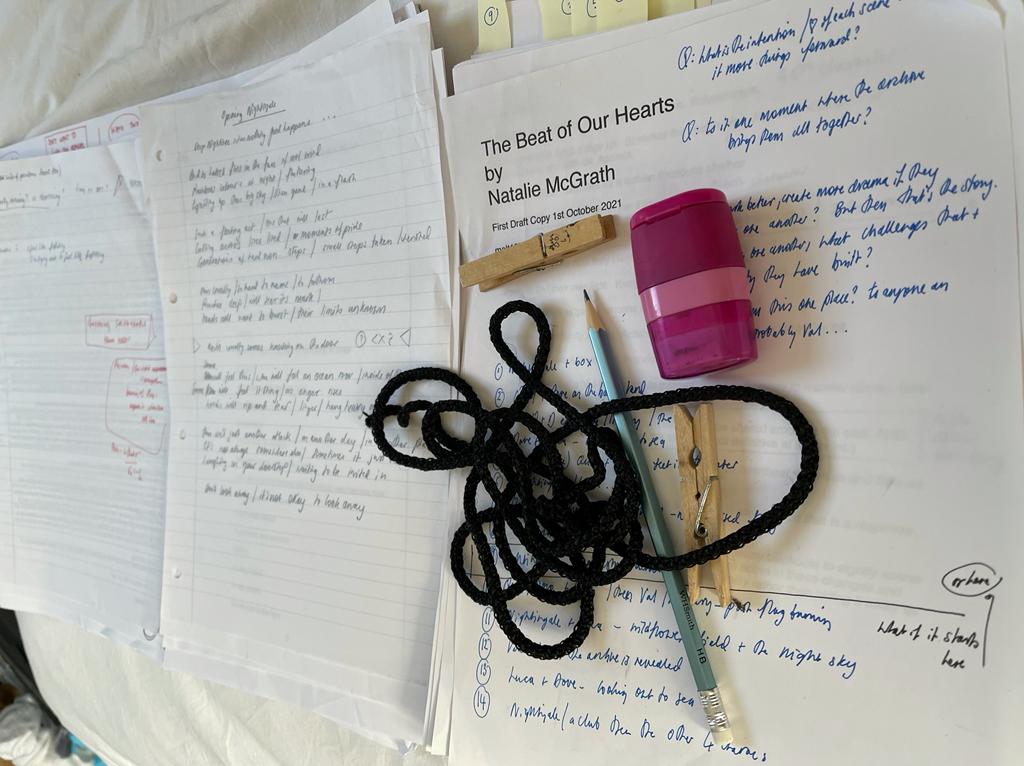the beat of our hearts
the beat of our hearts

Posted by rrov201
19 November 2021Last week we held a very special online preview performance of scenes from The Beat of Our Hearts, as part of the 2021 Being Human Festival. Our event even made it onto the Being Human 2021 promotional video!
The Being Human event – funded by both Arts Council England and the Wellcome Centre for Cultures and Environments of Health (University of Exeter) – was integral to a Research and Development week for Natalie McGrath, in writing the play. Meeting with performers, and discussing characters, plot, and themes with them and with the director, Scott Hurran, has proved invaluable in the overall drafting process.
I spoke to Natalie about the drafting process.
What were the main excitements and challenges you experienced when putting pen to paper for the first time on The Beat of Our Hearts?
Just to get going really after a long period of thinking, talking and absorbing research through reading and working with people through the workshops. To finally start to let some of that start to filter out and to start dreaming and imagining The Beat of Our Hearts was exciting. It is always daunting in those very early stages of a new play, where you are juggling so many possibilities and you want them all to be there. A presence in the work, knowing that as the process moves along that not all the dreaming will stay, but that it will have been a catalyst, a leap into something that will eventually make the story and the theatricality work.
I tend to scribble first in pencil and start to draft writing or what could turn into dialogue in pencil on paper first before I even sit down at the computer. Here I have been using large A3 sheets to map out all the ideas and to find out about that all important question: whose there? Who is in the world being created?
There are always a lot of red herrings early on. Usually the wildest stuff that just won’t make it onto the stage as it just isn’t serving the story in some way, but I will keep trying to squeeze some of these moments of ‘magic’ in for as long as I can!
How do you feel the workshops inspired you while completing your first draft?
The workshops were full of inspirational conversations and discussions. Full of humanity, humility, grace and generosity from all the participants. It hard to know where to begin. How to capture such a breadth of emotion and experiences. That’s a real challenge for me now writing the play. In a way the workshops have grounded me. Made me make some vital decisions.
One example; is that after all he workshops I changed the ages of some of the a characters to make the play more intergenerational and more representative of the age range of participants. It has shifted the dynamic and content of a lot of the current dialogue from the first draft into the second draft which is now emerging. So the original workshops really had a much younger focus as the impact of the early sessions struck a chord and took me back to my original intentions for having an idea of writing something that supported young LGBTQIA+ people and their experiences.
My challenge now is that everyone’s experiences are all so different, with different experiences of loneliness and what that means. So it is this I am trying to capture, but also the wonderful spirit of the people who took part and shared their stories.
Do you feel there’s something about the drafting process that also speaks to the experience of LGBTQIA+ loneliness and belonging?
Writing is a solitary process. Something where there comes a point where you are alone with the words and the drafting process or the editing process as it becomes, is slow and meticulous. I’m not quite sure how I can fully connect that to speaking to the experience of LGBTQIA+ loneliness and belonging. Perhaps I can only think it in terms of my own personal experiences of loneliness and belonging as a queer person. Growing up I felt very lonely and alone. Desperate to make connections with other LGBTQIA+ people.
I don’t think there was much if any time spent on those kinds of conversations. It still felt a bit dangerous to even meet other queers at that time. I wish that there had been conversations about loneliness and belonging at the time. It does feel stigmatised still as subject matter. So as I move into a further crafting and drafting process I will think about that and how we can more forward in a more positive way.
— Richard Vytniorgu